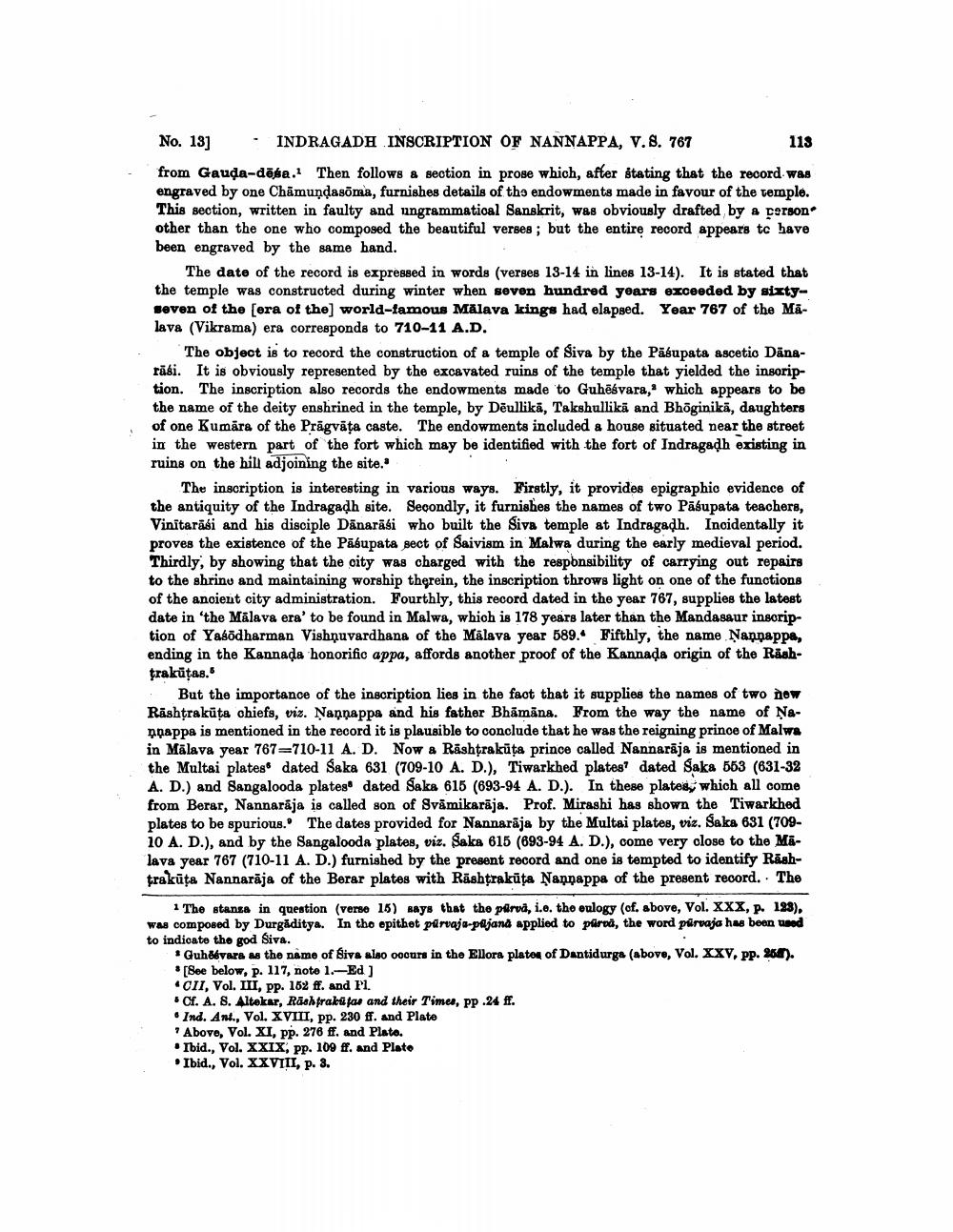________________
113
No. 13]
INDRAGADH INSCRIPTION OF NANNAPPA, V. 8. 767
from Gauḍa-desa. Then follows a section in prose which, after stating that the record was engraved by one Chamuṇḍasōma, furnishes details of the endowments made in favour of the temple. This section, written in faulty and ungrammatical Sanskrit, was obviously drafted by a person other than the one who composed the beautiful verses; but the entire record appears to have been engraved by the same hand.
The date of the record is expressed in words (verses 13-14 in lines 13-14). It is stated that the temple was constructed during winter when seven hundred years exceeded by sixtyseven of the [era of the] world-famous Mälava kings had elapsed. Year 767 of the Malava (Vikrama) era corresponds to 710-11 A.D.
The object is to record the construction of a temple of Siva by the Pasupata ascetic Danarasi. It is obviously represented by the excavated ruins of the temple that yielded the inscription. The inscription also records the endowments made to Guheśvara, which appears to be the name of the deity enshrined in the temple, by Deullikā, Takshullikā and Bhōginika, daughters of one Kumara of the Pragvata caste. The endowments included a house situated near the street in the western part of the fort which may be identified with the fort of Indragadh existing in ruins on the hill adjoining the site."
The inscription is interesting in various ways. Firstly, it provides epigraphic evidence of the antiquity of the Indragadh site. Secondly, it furnishes the names of two Pasupata teachers, Vinitarasi and his disciple Danarasi who built the Siva temple at Indragadh. Incidentally it proves the existence of the Pasupata sect of Saivism in Malwa during the early medieval period. Thirdly, by showing that the city was charged with the responsibility of carrying out repairs to the shrine and maintaining worship therein, the inscription throws light on one of the functions of the ancient city administration. Fourthly, this record dated in the year 767, supplies the latest date in 'the Malava era' to be found in Malwa, which is 178 years later than the Mandasaur inscription of Yasodharman Vishnuvardhana of the Malava year 589. Fifthly, the name Nanpappa, ending in the Kannada honorific appa, affords another proof of the Kannada origin of the Rashtrakūtas."
But the importance of the inscription lies in the fact that it supplies the names of two new Rashtrakuta chiefs, viz. Nannappa and his father Bhamana. From the way the name of Nanpappa is mentioned in the record it is plausible to conclude that he was the reigning prince of Malwa in Mälava year 767-710-11 A. D. Now a Rashtrakuṭa prince called Nannarāja is mentioned in the Multai plates dated Saka 631 (709-10 A. D.), Tiwarkhed plates? dated Saka 553 (631-32 A. D.) and Sangalooda plates dated Saka 615 (693-94 A. D.). In these plates, which all come from Berar, Nannaraja is called son of Svamikarāja. Prof. Mirashi has shown the Tiwarkhed plates to be spurious. The dates provided for Nannaraja by the Multai plates, viz. Saka 631 (70910 A. D.), and by the Sangalooda plates, viz. Saka 615 (693-94 A. D.), come very close to the Mālava year 767 (710-11 A. D.) furnished by the present record and one is tempted to identify Rashtrakūta Nannaraja of the Berar plates with Rashtrakuta Nanpappa of the present record. The
1 The stanza in question (verse 15) says that the purva, i.e. the eulogy (cf. above, Vol. XXX, p. 123), was composed by Durgaditya. In the epithet parvaja-pajana applied to pürva, the word purvaja has been used to indicate the god Siva.
* Guhêévara as the name of Siva also occurs in the Ellora plates of Dantidurga (above, Vol. XXV, pp. 25). [See below, p. 117, note 1.-Ed]
CII, Vol. III, pp. 152 ff. and Pl.
Cf. A. S. Altekar, Rashtrakutas and their Times, pp.24 ff.
Ind. Ant., Vol. XVIII, pp. 230 ff. and Plate
Above, Vol. XI, pp. 276 ff. and Plate.
Ibid., Vol. XXIX, pp. 109 ff. and Plate Ibid., Vol. XXVIII, p. 3.




